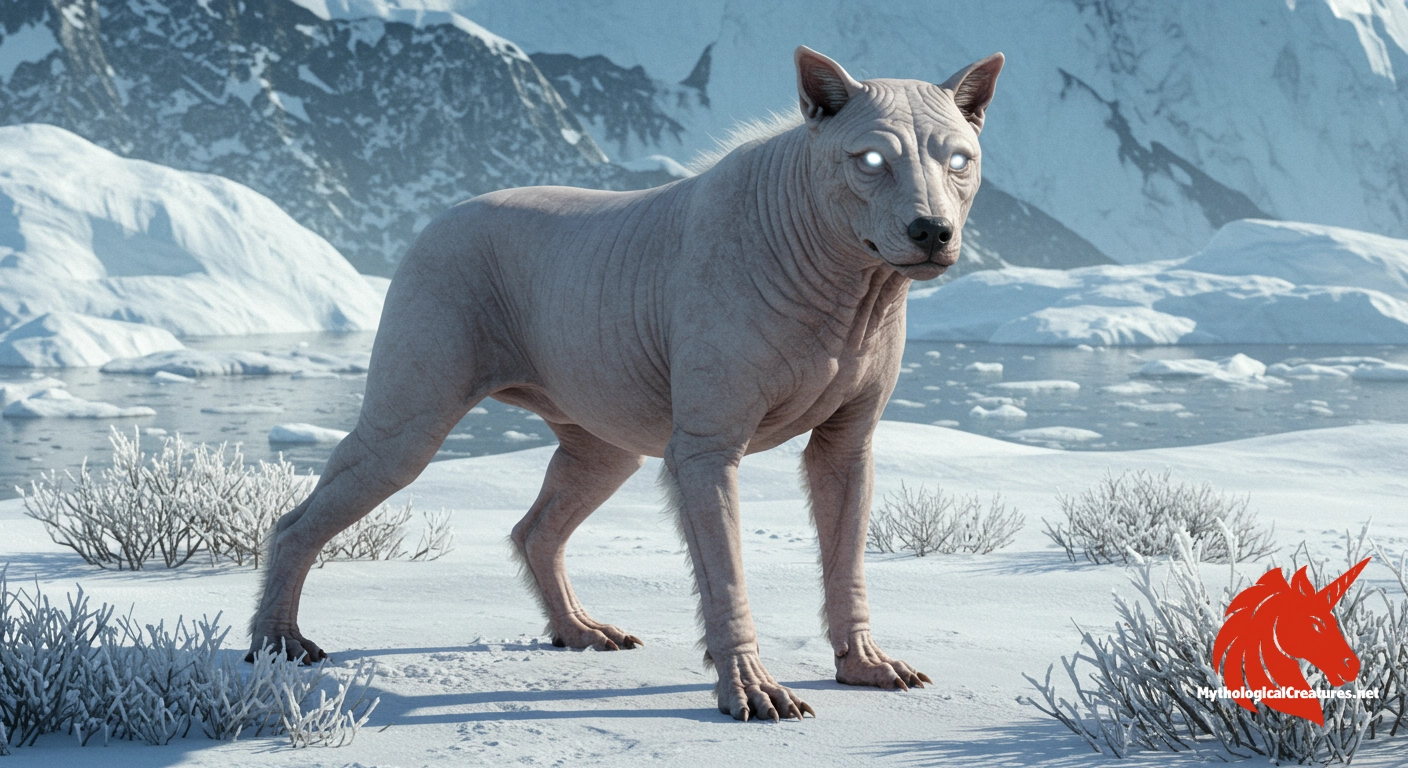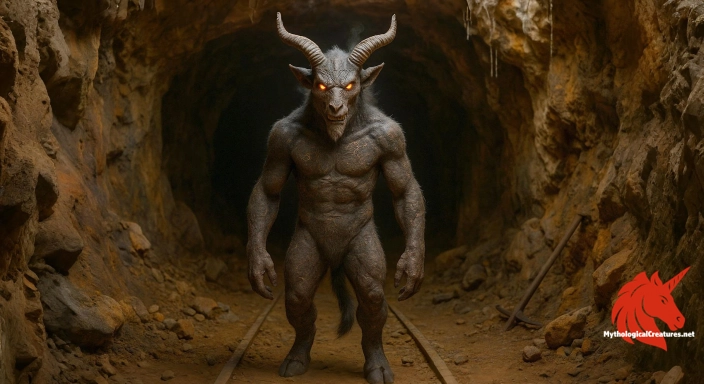Qiqirn: Qiqirn is a large, bald dog spirit from Inuit mythology that uniquely displays hair only on its feet, mouth, and the tips of its ears and tail.

Qiqirn
Qiqirn - Qiqirn’s convulsion-inducing presence is thought to be an allusion to shamanic initiations, underlining its role in the transformative rituals of Inuit culture.
Origins & First Encounters
The qiqirn is an enigmatic canine spirit central to Inuit cosmology, originating near the icy expanses of Baffin Island. Its presence emerged from a rich tapestry of oral lore, blending the tangible hardships of Arctic life with the ethereal realm of the supernatural. Early narratives capture the creature as a formidable force that defies ordinary expectations, straddling the line between fear and mysticism. The spirit is interwoven with the rituals of shamanic practice, where its uncanny appearances symbolise transformative experiences. Local folklore recounts how the qiqirn’s arrival can unsettle both humans and their canine companions. Its spectral manifestations are seen as both an omen and a test of spiritual endurance. The lore surrounding the creature encapsulates a delicate balance between natural phenomena and mystical intervention. Enduring through generations, its story remains a testament to the Inuit understanding of the unpredictable forces of nature. The qiqirn continues to inspire awe and caution, firmly embedded in the cultural memory of the region.
Source Texts & Tale Variants
Traditional narratives and oral histories form the primary repository of qiqirn accounts, preserved by generations of Inuit storytellers. These recitations, passed along by elders, capture the creature's mysterious appearances and unpredictable influence. Many tales focus on the qiqirn’s uncanny ability to induce convulsive fits in both men and dogs. Some versions attribute these episodes to rites of passage and shamanic initiations. Ethnographic records from the Arctic document various interpretations and subtle differences in the creature’s story. Multiple recordings reveal that the qiqirn is sometimes linked with similar malevolent spirits, such as the keelut, underscoring a shared mythological framework. Written accounts, though few, have attempted to preserve the essence of this elusive entity. Variations accumulate as the spirit’s legend is retold in different locales, each narrative adding its own layer of complexity. These diverse sources highlight a living tradition where myth and experience converge, enriching the qiqirn’s mystique. The fluidity of these narratives exemplifies how oral traditions adapt over time while continuing to evoke deep cultural and spiritual themes.
Form & Powers
The qiqirn is physically depicted as a large, bald canine imbued with a spectral presence that is both formidable and unnerving. It is notably hairless over much of its body, with the exception of sparse tufts on its feet, around its mouth, and at the tips of its ears and tail. This selective patchiness of fur creates an arresting contrast against an otherwise ghostly frame. Observers often remark on a faint luminescence to its skin, as if it absorbs the polar light into a soft, eerie glow. Its eyes are described as piercing, glinting with an intelligence that is as unsettling as it is profound. The creature’s build is robust, suggesting strength and endurance in the face of Arctic rigours. Its gait is an odd amalgam of ponderous heaviness and unexpected agility, adding to its mysterious allure. Each physical detail, from its barren coat to the hints of fur, reinforces the notion that the qiqirn exists at the boundary between the natural and the supernatural. The amalgamation of these features culminates in a visage that is as puzzling as it is iconic, challenging conventional notions of both beauty and beastliness.
Regional Faces
Across the sprawling Arctic, the visage of the qiqirn adapts according to regional storytelling and environmental context. Inuit communities, particularly those around Baffin Island, portray it as a spirit whose arrival is both portentous and exceptional. In some settlements, the creature is depicted primarily as a malevolent force capable of inciting convulsions and fear. Other communities weave in elements of spiritual initiation, suggesting that its appearance may signal transformative rites of passage. Local lore often integrates the qiqirn’s physical traits with broader symbolic meanings related to the stark conditions of the Arctic environment. Variations in description—such as the degree of hairlessness or its behavioural traits—reflect the diverse ways in which indigenous peoples interpret the mysterious forces around them. In certain regions, the qiqirn is mentioned alongside the keelut, underlining a shared mythic lineage that transcends individual community boundaries. Oral traditions display remarkable flexibility, adapting the narrative to address both everyday life and the extraordinary. These regional adaptations ensure that the spirit remains a dynamic element of the cultural imagination, tailored to the nuances of each local landscape.
Cultural Parallels
The figure of the qiqirn evokes comparisons with several spectral hound legends found around the globe. Its ghostly and fearsome attributes mirror those of the black dogs that haunt British folklore, where such apparitions are often omens of misfortune. Both the qiqirn and its Western counterparts occupy a liminal space between life and the mysterious otherworld, symbolising the threshold between the natural and the supernatural. Across various indigenous traditions in North America, similar canine entities serve as metaphors for spiritual transition and hidden knowledge. The shared motif of a spectral dog reflects a universal human response to the unknown, using animal forms to embody abstract fears and hopes. In this light, the qiqirn is part of a broader tapestry where creatures shrouded in mystery help communities navigate the uncertainties of life and death. Its depiction is not isolated but resonates with a network of legends that stress transformation and the trial of the spirit. These cross-cultural connections illuminate the common threads that connect disparate peoples through myth. Such comparative narratives deepen our understanding of the qiqirn as a multifaceted symbol that challenges and inspires across diverse cultural landscapes.
Legacy & Modern Evolution
Over time, the portrayal of the qiqirn has evolved from a purely ominous spectre to a multifaceted emblem of spiritual challenge and natural resilience. Its early reputation as a harbinger of fatal convulsive fits has expanded to encompass themes of transformation and mystic awakening. Contemporary reinterpretations have infused the creature with a renewed complexity, blending ancient shamanic symbolism with modern cultural narratives. Literary works and visual media now often depict the qiqirn as a symbol of the raw power of nature and the enduring mystery of the unseen world. Modern storytellers draw on its traditional traits while also exploring new dimensions of meaning, such as the reconciliation between old lore and contemporary values. Cultural festivals and academic discussions in the Arctic have revitalised interest in the creature, encouraging a re-examination of indigenous heritage. This evolution highlights an ongoing dialogue between the ancestral past and the present-day quest for identity and belonging. The enduring fascination with the qiqirn speaks to a universal need to understand and personify the forces that lie beyond human control. As the myth is retold in varied contexts—from local gatherings to international forums—it continues to captivate and challenge audiences. The qiqirn stands as an enduring icon, bridging the gap between ancient tradition and the modern quest for meaning in a changing world.
Interesting Fact
An intriguing aspect of Qiqirn is that its convulsion-inducing presence, while deadly, is interpreted by some scholars as an ambivalent sign of shamanic initiation, reflecting the complex relationship between danger and transformation in Inuit spirituality.
Quick Creature Info
Origin:
Features:
Our Mythic Legendary Rating:

Habitat:
Supernatural Powers:
Physical Attributes:
Abilities:
Behavior:
Weaknesses:
Lore:
Related Creatures, Tales or Lore
- KKeelut
- BBlack Shuck
- CCŵn Annwn
References
Discover Another Mythical Legend You May Not Have Heard Of?
Uncover the mysteries of ancient folklore and expand your knowledge of legendary beings from cultures around the world.
Dare to Meet the El Tío....
Curated by the Mythological Creatures Team (rev. May 2025)
